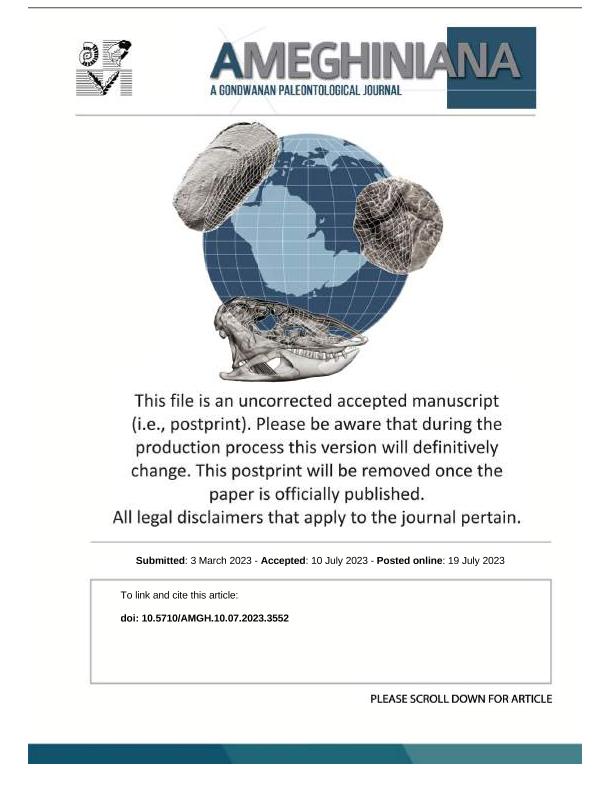Artículo
Una de las especies de bivalvos más abundantes que habita en la playas y depósitos cuaternarios del Golfo San Matías (Patagonia argentina, Océano Atlántico sudoccidental) es Glycymeris longior. Su gran abundancia y amplia distribución geográfica, hacen que G. longior sea una especie objetivo para estudios tafonómicos. Por lo cual, describimos el perfil tafonómico que registran sus valvas en la Bahía San Antonio (Golfo San Matías, Argentina) con el objetivo de contribuir a futuras comparaciones tafonómicas, con material de playas actuales o de depósitos cuaternarios donde esta especie se encuentre. Las valvas de G. longior de los depósitos holocenos de Punta Delgado mostraron dos patrones de preservación diferentes caracterizados por diferencias en la intensidad de fragmentación, redondeamiento y cementación de sus valvas. Las valvas de PD2018A y PD2018B estuvieron sometidas a un flujo de agua continuo y poco intenso. Éstas permanecieron en la interfase sedimento-agua con menor intensidad hidrodinámica, lo que favorecería una alta cementación. Por otro lado, las valvas de PD2016 estuvieron sujetas también a un flujo de agua continuo, pero más intenso o energético. Éstas permanecerían en la zona tafonómicamente activa el tiempo suficiente para producir bordes redondeados y ser colonizadas por las esponjas cliónidas pero no lo suficientemente para la precipitación de carbonatos. El sitio Punta Delgado se interpretó como una zona protegida durante el Holoceno (últimos 4200 años) similar a la actual, pero con diferencias en la precipitación de carbonatos como producto de las distintas intensidades del flujo de agua. Finalmente, la alta resistencia mecánica de las valvas de G. longior, junto con su abundancia y amplia distribución geográfica convierten a esta especie en un taxón adecuado para análisis y comparaciones futuras. One of the most abundant species of bivalves found on modern beaches and Quaternary deposits in the San Matías Gulf (Argentinian Patagonia, SW Atlantic Ocean) is Glycymeris longior. Its high abundance and broad geographical distribution turn G. longior into a target species for taphonomical studies. Here, we described the taphonomic signature registered on its shells from San Antonio Bay (San Matías Gulf, Río Negro). This study will contribute to future taphonomic comparisons in the SW Atlantic Ocean, as well as in other Quaternary deposits, and provide insight into the spatial variation of the taphonomic processes influenced by the environment. Glycymeris longior valves from the Holocene Punta Delgado deposits showed two taphonomic signatures whose shell assemblages were differentiated by fragmentation, rounding and cementation intensities. Shells from PD2018A and PD2018B (two sampling localities representing similar environments) were subject to continuous and low-energy water flow. Those remained in a low-intensity hydrodynamic sediment-water interface that would favor high shell cementation. On the other hand, shells from PD2016 were also subject to continuous but more energetic water flow. Those would remain in the taphonomic active zone for enough time to confer smooth edges and to be colonized by clionid sponges but not favorable enough for carbonate precipitation. The Punta Delgado site was interpreted as a protected area during the Holocene (last 4200 yrs.), similar to the modern one, but with differences in carbonate precipitation as the product of differences in water flow intensities. Finally, the high mechanical resistance of G. longior shells, together with its abundance and broad geographical distribution, turn this species into a suitable target taxon for further taphonomic and ecologic analyses and comparisons.
Taphonomic Signature of Glycymeris longior Shells (Bivalvia) and its Potential as Paleoenvironmental Proxy for the Quaternary of Northern Patagonia (Argentina)
Título:
Perfil tafonómico de valvas de Glycymeris longior (Bivalvia) como Proxi paleoambiental para el cuaternario de Patagonia Norte (Argentina)
Bayer, María Sol ; Nobile, Julieta
; Nobile, Julieta ; Muñoz, Diego Fernando
; Muñoz, Diego Fernando ; Morsan, Enrique Mario
; Morsan, Enrique Mario ; Morán, Ariana Gisela
; Morán, Ariana Gisela ; Fucks, Enrique Eduardo; Gordillo, Sandra
; Fucks, Enrique Eduardo; Gordillo, Sandra
 ; Nobile, Julieta
; Nobile, Julieta ; Muñoz, Diego Fernando
; Muñoz, Diego Fernando ; Morsan, Enrique Mario
; Morsan, Enrique Mario ; Morán, Ariana Gisela
; Morán, Ariana Gisela ; Fucks, Enrique Eduardo; Gordillo, Sandra
; Fucks, Enrique Eduardo; Gordillo, Sandra
Fecha de publicación:
08/2023
Editorial:
Asociación Paleontológica Argentina
Revista:
Ameghiniana
ISSN:
0002-7014
e-ISSN:
1851-8044
Idioma:
Inglés
Tipo de recurso:
Artículo publicado
Clasificación temática:
Resumen
Archivos asociados
Licencia
Identificadores
Colecciones
Articulos(CICTERRA)
Articulos de CENTRO DE INVEST.EN CS.DE LA TIERRA
Articulos de CENTRO DE INVEST.EN CS.DE LA TIERRA
Articulos(CIMAS)
Articulos de CENTRO DE INVESTIGACION APLICADA Y TRANSFERENCIA TECNOLOGICA EN RECURSOS MARINOS "ALMIRANTE STORNI"
Articulos de CENTRO DE INVESTIGACION APLICADA Y TRANSFERENCIA TECNOLOGICA EN RECURSOS MARINOS "ALMIRANTE STORNI"
Articulos(IDACOR)
Articulos de INSTITUTO DE ANTROPOLOGIA DE CORDOBA
Articulos de INSTITUTO DE ANTROPOLOGIA DE CORDOBA
Articulos(IDEA)
Articulos de INSTITUTO DE DIVERSIDAD Y ECOLOGIA ANIMAL
Articulos de INSTITUTO DE DIVERSIDAD Y ECOLOGIA ANIMAL
Citación
Bayer, María Sol; Nobile, Julieta; Muñoz, Diego Fernando; Morsan, Enrique Mario; Morán, Ariana Gisela; et al.; Taphonomic Signature of Glycymeris longior Shells (Bivalvia) and its Potential as Paleoenvironmental Proxy for the Quaternary of Northern Patagonia (Argentina); Asociación Paleontológica Argentina; Ameghiniana; 60; 5; 8-2023; 450-464
Compartir
Altmétricas



